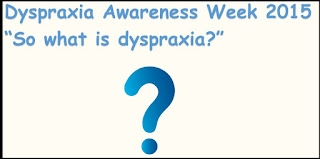This week is Dyspraxia awareness week (11th- 17th October), it’s probably one of my favourite weeks of the year as raising awareness of dyspraxia is something which as many of you have guessed is something I’m very passionate about. This week I will be speaking at Dyspraxia Westminster group, attending The Houses of Parliament, and visiting Dyspraxia Foundation HQ for Funky Friday, I will also be blogging with fellow dyspraxics Kerry Pace from Diverse Learners and her daughter Phoebe.
To kick start my blogs for dyspraxia awareness week I thought I would blog about what seems to be one of the most common questions asked to dyspraxics “so what is dyspraxia?” then a confused, puzzled look. It’s the hidden difference society hasn’t heard of, and is very misunderstood and that needs to change.
The lovely Natalie has written a really informative blog 10 facts about dyspraxia please have a read of it, let’s raise as much awareness of dyspraxia as we can:
https://theblogwithonepost.wordpress.com/2015/10/11/dyspraxia-awareness-week-2015-10-facts-about-dyspraxia
At some point in life you’re guaranteed to come across someone with dyspraxia, whether it be a family member, friend or loved one, someone in your school, university or workplace or simply in day to day life in the street, on public transport or in a shop. You never know who you meet who might be dyspraxic, so I hope this blog helps others understand a little more.
1. Dyspraxia is when the wires in the brain get crossed and the signals and messages to the body get muddle, which means the brain is saying one thing and the body ends up doing something completely else. It is also hidden which means by looking at someone you can’t tell someone has it.
2. Dyspraxia is so much more to being clumsy, although I do find lots of random bruises end up coming from nowhere and I have no idea when or where from. It can effect co-ordination, spatial awareness, fine motor skills, sensory sensitivity, social and emotional issues. No two people with dyspraxia are the same we are all different and unique.
3. Dyspraxia is all the things in life others take for granted and don’t have to think about such as going up and down stairs, tasks which require fine motor skills, being able to cross the road, cook and prepare a meal or navigate public transport are just a few for some people.
4. When we carry out tasks our brains are taking ten times longer to process the information or carry out the task, it doesn’t mean that we are being lazy or not putting any effort in, we just need more time, some patience and understanding that tasks can make us prone to fatigue and tiredness.
5. Just because someone with dyspraxia has reached a good level academically doesn’t mean they have grown out of their dyspraxia, dyspraxia is life long and managing adult life with dyspraxia can be tricky, frustrating and overwhelming at times.
6. Every day is different, one day we might have mastered a task, the next day it might all literally fall apart, we have good days and bad days and some days when nothing goes to plan at all, this can really effect our confidence and self esteem.
7. People with dyspraxia are quirky, unique individuals, and all are very different in our quirks. Difference is nothing to be scared of it just means our brains are wired in a different way and we process the world is in a different way It means we can be very creative and see the bigger picture and think outside the box. We are very passionate people and passionate about our interests, hobbies and the causes we support, some people may say it’s over enthusiasm and not understand why but get to know us and don’t make assumptions.
8. People with dyspraxia may find making and maintaining friends difficult and find some social situations tricky, but once we trust someone we can be very loyal, kind hearted, understanding, caring people who will go out of our way to help others.
9. Living with dyspraxia can be difficult, but we never give up, we’re very determined and resilient.
10. Finally, always remember there’s a person behind their dyspraxia and don’t define someone by their dyspraxia.
